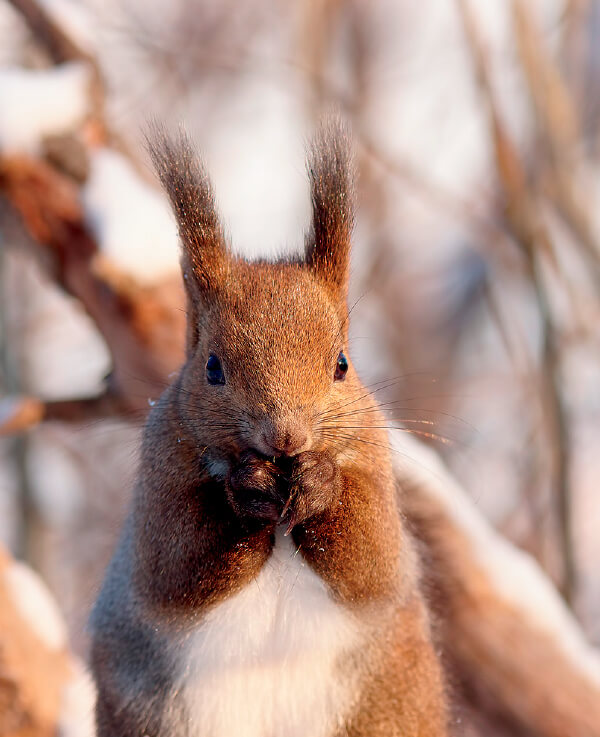Every fall, the Eastern Grey Squirrel hides thousands of nuts in preparation for winter. They are the ultimate meal planners with a fantastic sense of smell!
Activity Objective:
This activity is a nature-themed exercise in memory-building. It provides an opportunity to review what the students learned at the Environment Centre, while also providing a new challenge with which to engage. Begin with some fun squirrel stretches and movements. Review what sorts of food squirrels prefer to eat and discuss how these small creatures ensure that they have food available all winter long.
Tools and Materials:
- Schoolyard, Park or Woodland
- Nuts/Seeds (Acorns, Sunflower Seeds, Conifer Cones, etc.)
- Seeds/nuts are bound to get lost… please use natural/ native items ONLY
Eastern Grey Squirrel Diet:
What’s on the menu?
- Spring – buds from hardwood trees, especially maple
- Summer – winged seeds of maples (samaras) and elm seeds, berries, and other wild fruits, seeds, nuts, and apples
- Autumn and Winter- hard nuts (acorns, butternuts, beechnuts, hickory nuts, walnuts, and pine seeds) •Occasional Treats: insects, caterpillars, birds’ eggs or young birds
Let’s imagine that we are Squirrels…
- Give each student a small handful of ‘nuts’ and instruct them to hide their food for winter (5-10 nuts/ seeds per student; larger nut numbers will provide greater challenge). Eastern Grey Squirrels like to spread out their food stashes and will select thousands of different hiding spaces for their caches each year! Similar to Eastern Grey Squirrels, students must find a separate hiding spot for each nut. The catch? Students must use their memory to recall where each nut is hidden. To minimize disappointment, it is essential to caution students that they will most likely lose some of their food. Some nuts will simply be lost, while others may be inadvertently taken by other hungry ‘squirrels’ (students). That is a normal part of squirrel life.
- Allow students a few minutes to complete the task. Gather students and play a short game, tell some jokes, or share a quick story. The lapse of time and distraction is designed to provide the memory challenge. Afterward, instruct students to collect 1-2 of their hidden nuts and return to the group. Repeat the process as many times as is fit.
Questions for Reflection:
How many of your original seeds were you able to locate? What were your best hiding spots? Would squirrels use similar hiding spots to the ones you chose for yourself? What strategies did you use to remember where you hid your food? (Eastern Grey Squirrels have a strong sense of smell that enables them to sense their food from a distance. They will also sometimes create landmarks to help them locate their caches!)
Variation:
There is a theory that Blue Jays will sometimes mimic hawks to scare songbirds and small mammals away from valued food sources. In this game variation, select two students to be Blue Jays. While the squirrels attempt to hide their food, the blue jays will try to collect as many nuts as possible.
They do this in two ways:
- Tag a squirrel. The squirrel then gives the blue jay one of their nuts (if possible).
- The blue jays can attempt to find and collect hidden nuts.
Rules for Consideration:
- This variation works best when squirrels are tasked with hiding larger quantities of nuts (i.e. 8-10). Due to the additional complexity, this variation is best played with experienced ‘squirrels’ (i.e. Grades 2-3).
- Give squirrels a head start on hiding their food. In the first round, Blue Jays turn their backs and cover their eyes for the first 30 seconds – minute of gameplay.
- Blue Jays cannot tag the same squirrel twice in a row.
- Blue Jays cannot follow squirrels to their cache, but they can watch and take later… If a squirrel spots a blue jay taking one of their nuts, they can tag them and retrieve it. Like the best of us, squirrels sometimes forget their hiding spots. Can you blame them?!? Not to worry, many lost and forgotten seeds and nuts become food for other creatures. Any seeds and nuts that remain hidden and uneaten may sprout and grow into new plants and trees. We can thank the squirrels for planting several of the forests we enjoy today. Thank you Squirrels ❤

